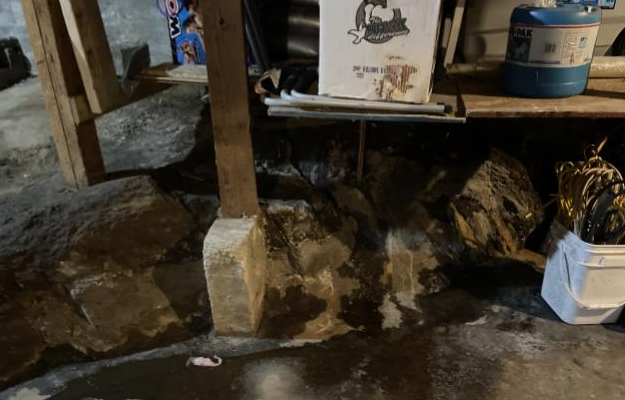- Photo: Bedrock in the crawlspace with water seeping through and around the rock surface.
- Abstract: North Shore and Sunshine Coast home inspector discusses how bedrock contributes to a wet crawlspace.
House Built on Rock
A house built on a bedrock is not that unusual in our part of the province. Today’s methods, with the measured use of blasting technology, allow contractors to build on bedrock efficiently and provide an excellent base for foundations while at the same time, limiting water ingress. But what of a house built decades ago, when these techniques were not available? Then the house was built essentially on undisturbed bedrock.
Recently we inspected a house built 86 years ago, where water pooling in the crawl space was reported. During the inspection, we identified two sources of water ingress… first, where the rock was directly contacting the perimeter foundations and second, water was seeping through the rock itself, likely due to fractures within the rock. There was evidence of prior attempts to mitigate the water flow, a pit with a sump pump had been installed.
Items for Improvement
We could not predict how severe the leakage would become and recommended to the client a further review be performed by a Civil Engineer. The Engineer subsequently visited the site. His opinion was that issues of this nature are difficult to correct, and the recommendations were very much in line with what we had suggested in our report, which included:
- Replace the old sump pump with a new unit and provide battery back-up power.
- Improve the ventilation of the crawl space to prevent any organic growth and odours.
- Consider some form of damp-proofing such as a thick 6 mm polyethylene (poly) sheeting placed over the bare ground and rock surfaces. This will limit the ‘rising damp’ within the crawlspace.
- As an additional measure, a thin layer of cement can be sprayed or troweled over the poly to hold it in place, while still maintaining drainage to the sump. The cement layer protects the poly from movement or damage, especially if the area will be actively used for storage. Even gravel could be placed over the poly for ballast, to keep the sheeting in place.
Reality Check
Whenever bedrock exists in a crawl space, it will be a challenge to keep the area dry. Bedrock prevents downward movement of rainwater or surface water runoff, forcing water to flow horizontally as it follows the slope. In most situations, weeping tile, drainage membrane or waterproof coatings will not eliminate the water migration through the crawlspace.
In this case, considering the age of the house, it is best to acknowledge that water will always come in and to include some of the above corrective measures.

